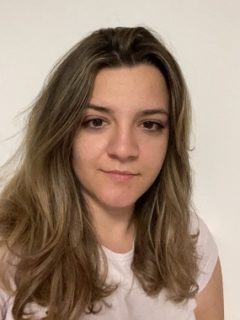Alexandra Ardelean
Alexandra Ardelean
Bachelor student
Development of melt electro written polycaprolactone composites for wound healing applications
Supervisor: Irem Unalan, Prof. Aldo Boccaccini
The physiological wound healing process involves a cascade of events influenced by various factors that lead to chronic, non-healing wounds [1]. Bacterial infections play a critical health concern in healing skin damage, which could delay the healing process [2]. In this context, the combination of advanced biomaterials, such as mesoporous bioactive glass (nano)particles following a technology recently developed in the Erlangen Institute of Biomaterials [3,4], could be an alternative approach to enhance wound dressings antioxidant, antibacterial and biological activities. Melt electrowriting (MEW) is a recently developed technology to produce highly porous scaffolds composed of synthetic biodegradable polymers. With this technique, polymer melts can be processed via a high voltage field to highly defined scaffolds [5]. This Bachelor thesis will investigate MEW-based scaffolds containing nanoparticles regarding their physical, mechanical, chemical, and biological properties.
[1] Thomas E. Paterson, et al., Multifunctional Copper-Containing Mesoporous Glass Nanoparticles as Antibacterial and Proangiogenic Agents for Chronic Wounds, Front. Bioeng. Biotechnol. 8 (2020) 246.
[2] S. Homaeigohar, A.R. Boccaccini, Antibacterial biohybrid nanofibers for wound dressings, Acta Biomaterialia 107 (2020) 25-49.
[3] K. Zheng, P., et al., Ag modified mesoporous bioactive glass nanoparticles for enhanced antibacterial activity in 3D infected skin model, Mater. Sci. Eng. C. 103 (2019) 109764.
[4] Monavari, M., et al., 3D printing of alginate dialdehyde-gelatin (ADA-GEL) hydrogels incorporating phytotherapeutic icariin loaded mesoporous SiO2-CaO nanoparticles for bone tissue engineering. Materials Science and Engineering: C, 131 (2021) 112470
[5] Hochleitner, G., et al., Melt electrospinning writing of defined scaffolds using polylactidepoly(ethylene glycol) blends with 45S5 bioactive glass particles. Materials Letters, 205 (2017) 257–260.

